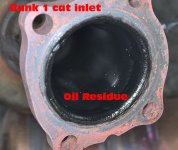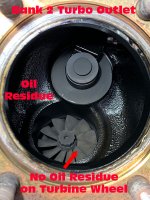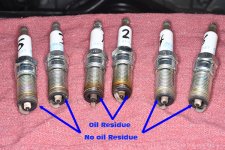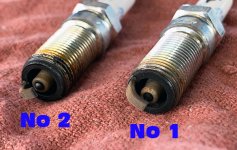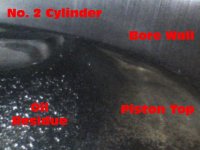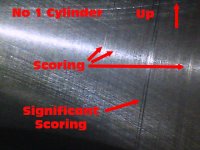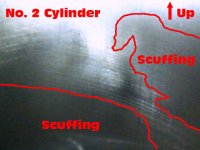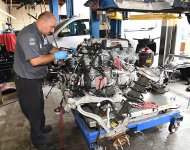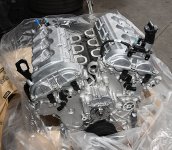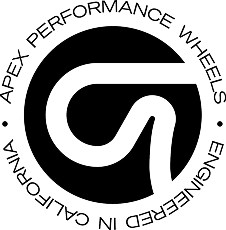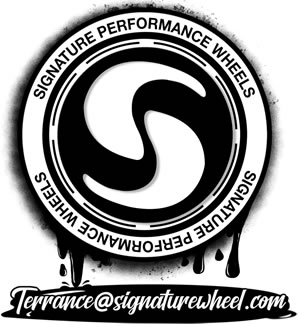Hib Halverson
Technical Writer for Internet & Print Media
- Joined
- Mar 20, 2015
- Messages
- 229
- Location
- CenCoast CA
- V-Series Cadillac(s)?
- 2016 ATS-V Sedan, 2016 ATS-V Coupe
ATS-Vs have great brakes. They stop the car in short distances. They have great pedal feel and the OE pads do not exhibit significant fade when driven properly in a performance street duty cycle.
In a brilliant use of "parts barrel engineering", GM introduced the 2016 ATS-V with the brakes off the previous generation of CTS-V and that made for a car with plenty of braking capacity. On the front are Brembo six-piston fixed calipers and 14.5-in rotors. At the rear are four-piston Brembo fixed calipers and 13.3-in rotors. In conjunction with this hardware, the ATS-V's brake hydraulics provide excellent pedal feel. The master cylinder and brake booster are a system that results in a firm pedal with little hysteresis, ie: pedal movement results in a corresponding increase in braking. It’s a “goldilocks” system in that the pedal is not rock hard with no travel nor is the pedal stroke too long making it feel soft. It’s just right such that the driver has the expected amount of braking from a given pedal movement and, thus, enhances driver confidence in maximum performance breaking situations. That confidence is one of the reasons that the little V is just a ball to drive hard.
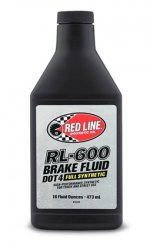
For track use GM recommends using a brake fluid with a higher boiling point. I flushed my brakes and refilled the system with Red Line RL600, a DOT4-rated fluid with a 604° dry boiling point and a 400° wet boiling point. RL600 maintains viscosity and lubricity and resists compressibility at extreme temperatures to help safeguard against brake fade and vapor lock in racing, performance and street applications.
Another mod I’m going to make to my six-speed coupe, the Blue BMW Buster, is a brake pad change from OE to a set of Porterfield R4-S pads. During the late-‘00s and early ‘10s, I had experience with the R4-S material in building a street/track 2001 Chevy Camaro project car for magazines and the Internet. Based on that, I think the R4-S pads, which are characterized by Porterfield Enterprises as a hi-po street, autocross and street/track pad, may offer an improvement in braking in a track duty-cycle and they will create less brake dust on the wheels in long-term street driving situations. I plan to install the Porterfields fairly soon.
Lastly, on the subject of brakes, our other ATS-V, “Pearl,” the four-door which is my Wife, the Fairest Sandra the Red, drives every day is 3 ½ years old and has gone 45,000 miles. It was time to flush and bleed the brakes as well as checking pads and rotor thicknesses. Two weeks ago, I got the car up in the air, pulled the wheels then got out my mic and measured the rotors. All of them had .030-In wear. Allowable reduction in thickness before discard is .080-in so there is plenty of life left in those rotors. Brake pads are 60-65% used. My Wife is easy on brakes so I think we have another 20-25,000 miles to go before we need new pads and then we’ll likely be able to put a second set of pads on the car before those rotors are used up. Not only has rotor and pad wear been acceptable but there have been zero problems with rotor warpage, hard-spots or pad material transfer.
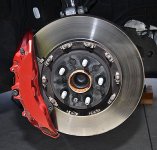
Brakes on Pearl after 45,000 miles.
Cheers to Brembo for building a great set of brakes for ATS-Vs. chug:
chug:
In a brilliant use of "parts barrel engineering", GM introduced the 2016 ATS-V with the brakes off the previous generation of CTS-V and that made for a car with plenty of braking capacity. On the front are Brembo six-piston fixed calipers and 14.5-in rotors. At the rear are four-piston Brembo fixed calipers and 13.3-in rotors. In conjunction with this hardware, the ATS-V's brake hydraulics provide excellent pedal feel. The master cylinder and brake booster are a system that results in a firm pedal with little hysteresis, ie: pedal movement results in a corresponding increase in braking. It’s a “goldilocks” system in that the pedal is not rock hard with no travel nor is the pedal stroke too long making it feel soft. It’s just right such that the driver has the expected amount of braking from a given pedal movement and, thus, enhances driver confidence in maximum performance breaking situations. That confidence is one of the reasons that the little V is just a ball to drive hard.

For track use GM recommends using a brake fluid with a higher boiling point. I flushed my brakes and refilled the system with Red Line RL600, a DOT4-rated fluid with a 604° dry boiling point and a 400° wet boiling point. RL600 maintains viscosity and lubricity and resists compressibility at extreme temperatures to help safeguard against brake fade and vapor lock in racing, performance and street applications.
Another mod I’m going to make to my six-speed coupe, the Blue BMW Buster, is a brake pad change from OE to a set of Porterfield R4-S pads. During the late-‘00s and early ‘10s, I had experience with the R4-S material in building a street/track 2001 Chevy Camaro project car for magazines and the Internet. Based on that, I think the R4-S pads, which are characterized by Porterfield Enterprises as a hi-po street, autocross and street/track pad, may offer an improvement in braking in a track duty-cycle and they will create less brake dust on the wheels in long-term street driving situations. I plan to install the Porterfields fairly soon.
Lastly, on the subject of brakes, our other ATS-V, “Pearl,” the four-door which is my Wife, the Fairest Sandra the Red, drives every day is 3 ½ years old and has gone 45,000 miles. It was time to flush and bleed the brakes as well as checking pads and rotor thicknesses. Two weeks ago, I got the car up in the air, pulled the wheels then got out my mic and measured the rotors. All of them had .030-In wear. Allowable reduction in thickness before discard is .080-in so there is plenty of life left in those rotors. Brake pads are 60-65% used. My Wife is easy on brakes so I think we have another 20-25,000 miles to go before we need new pads and then we’ll likely be able to put a second set of pads on the car before those rotors are used up. Not only has rotor and pad wear been acceptable but there have been zero problems with rotor warpage, hard-spots or pad material transfer.

Brakes on Pearl after 45,000 miles.
Cheers to Brembo for building a great set of brakes for ATS-Vs.
 chug:
chug:
 :
: